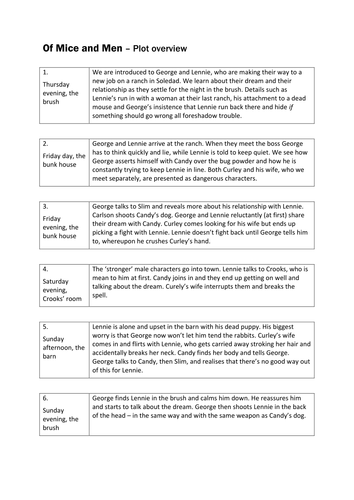




There's more in here than you could fit into an hour-long lesson, so choose your favourites and/or set homework!
I like to start with the *plot overview*, drawing attention to the way that each chapter is set at a particular time of day and in one particular place. I also talk about the structure of the novel, about how both hope and a sense of impending trouble build and build until the death of Curley's wife, at which point tragedy prevails and all hope is lost.
I then move onto *the creation and function of characters*, explaining how different techniques are used to create characters, different characters represent different themes, and different themes are used to communicate particular ideas/the author's main messages. Some techniques for creating characters are given - can students think of any more? Can they name nine characters and give two words to describe each in the next row? Then, can they think of themes that each character represents? Then finally, what does Steinbeck tell us about these themes? What are his main ideas/messages in the novel? This works well as a group activity as it gets students talking about the characters in depth and thinking about their role in the book. The idea is to help them to understand how the characters have been created very deliberately and purposefully to help Steinbeck communicate something. As an extension, there is then space where three characters can be analysed in more depth.
There are three AQA *exam-style questions*, where the first part of the question asks the student to respond to an excerpt and the second asks how something is presented in the rest of the novel, considering the historical context. Question C on ambitions and opportunities is my favourite and ties in well with the above analysis of characters. I like to discuss the first part of the question, then briefly revise context with the *US in the 1930s* sheet before moving on to the second part of the question. These questions could be used for group discussion, essay plans or full independent essay-writing practice.
Some *quotes* are also included. Each quote has a point sentence; students could be asked to pick a few and add analysis.
I like to start with the *plot overview*, drawing attention to the way that each chapter is set at a particular time of day and in one particular place. I also talk about the structure of the novel, about how both hope and a sense of impending trouble build and build until the death of Curley's wife, at which point tragedy prevails and all hope is lost.
I then move onto *the creation and function of characters*, explaining how different techniques are used to create characters, different characters represent different themes, and different themes are used to communicate particular ideas/the author's main messages. Some techniques for creating characters are given - can students think of any more? Can they name nine characters and give two words to describe each in the next row? Then, can they think of themes that each character represents? Then finally, what does Steinbeck tell us about these themes? What are his main ideas/messages in the novel? This works well as a group activity as it gets students talking about the characters in depth and thinking about their role in the book. The idea is to help them to understand how the characters have been created very deliberately and purposefully to help Steinbeck communicate something. As an extension, there is then space where three characters can be analysed in more depth.
There are three AQA *exam-style questions*, where the first part of the question asks the student to respond to an excerpt and the second asks how something is presented in the rest of the novel, considering the historical context. Question C on ambitions and opportunities is my favourite and ties in well with the above analysis of characters. I like to discuss the first part of the question, then briefly revise context with the *US in the 1930s* sheet before moving on to the second part of the question. These questions could be used for group discussion, essay plans or full independent essay-writing practice.
Some *quotes* are also included. Each quote has a point sentence; students could be asked to pick a few and add analysis.
Something went wrong, please try again later.
This resource hasn't been reviewed yet
To ensure quality for our reviews, only customers who have purchased this resource can review it
Report this resourceto let us know if it violates our terms and conditions.
Our customer service team will review your report and will be in touch.
£3.00
